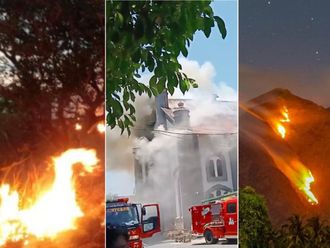Manila: Flights and sailings in the Bicol Region have been ordered cancelled by authorities as tropical depression Kalmaegi made its presence felt in the southeastern areas of Luzon Island as well as the northeast.
According to state weather bureau PAGASA, Kalmaegi (referred to in the Philippines as “Ramon”) is treading towards a west-northwestward direction and will make landfall in Palanan, Isabela in Northern Luzon by Monday. The weather disturbance is already bring rains in some parts of the country.
Kalmaegi, the 11th to hit the country for the year, was initially moving at a 15 kilometres per hour (KPH) clip, but it has slowed down to a speed of 11kph.
“Today, light to moderate with intermittent heavy rains will be experienced over Bicol Region and the eastern portions of Isabela and Cagayan. Tomorrow, (Friday) light to moderate with occasional heavy rains may be experienced over the eastern portion of Cagayan and Isabela. Light to moderate with intermittent heavy rains over Apayao, Quirino, Northern Aurora and the rest of Cagayan and Isabela.,” PAGASA said.
Kalmaegi is bringing in 75kph winds. Its arrival closely follows another weather disturbance which brought flooding in certain areas in Isabela province.
Schools in the Bicol Region have already cancelled classes for Friday. Local carriers have also notified passengers of delayed flights to the Bicol until the weather improves.
According to the Philippine Coast Guard, more than 4,400 passengers and cargo trucks have been stranded since Thursday afternoon in the ports in Albay, Camarines Sur, Catanduanes, Sorsogon, and Northern Samar.
Kalmaegi is forecasted to exit the Philippine Area of Responsibility by Wednesday and head for Taiwan.
Every year, dozens of lives and billions of pesos are lost to effects of weather disturbances such as flooding and landslides.
One of the most devastating typhoons to hit the country was Haiyan (Yolanda) which struck the Visayas islands in November 2013.
Former senator and now Congressional Representative of the Island of Antique, Loren Legarda, said: “Yolanda was a tragic example of how natural hazards caused by climate change could severely impact on people’s lives, properties, and well-being. With the grave projections from the latest climate science, it is even more important to prepare for these extreme weather events.”
Recently, the Green Climate Fund (GCF), which convened for the 24th Board Meeting in Songdo, South Korea, approved the $10 million grant to the Philippines’ proposed project for the establishment of multi-hazard impact-based forecasting and early warning systems and services (MH-IBF-EWS) that aims to strengthen and ensure the delivery of actionable and timely early warning to communities at risk of impending natural hazards.
“The Philippines needs to effectively reduce disaster risk as its effects have become more complex. The approval of the grant by the Green Climate Fund is very timely, not only as we commemorate this month the onslaught of Typhoon Yolanda 6 years ago, but also because of the increasing frequency and uncertainty of extreme hazard events that we have faced these past months and years,” Legarda, who is Deputy Speaker Loren said on Thursday.











